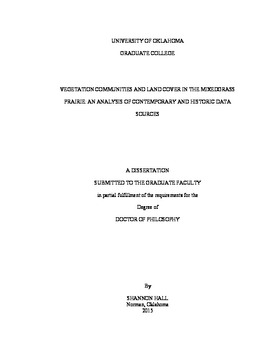| dc.description.abstract | This dissertation used both quantitative and qualitative applications to ascertain historic and contemporary vegetation cover, and determine if and to what extent vegetation change has occurred. In Chapter 1, I examined the effects of woody vegetation on the herbaceous plant community in three woody plant associations in the mixedgrass prairie; sand sage shrublands (Artemisia filifolia/Sporobolus cryptandrus - Schizachyrium scoparium shrubland association), shinnery oak shrublands (Quercus havardii /Sporobolus cryptandrus - Schizachyrium scoparium shrubland association), and honey mesquite shrublands (Prosopis glandulosa/Bouteloua gracilis-Buchloe dactyloides shrubland association). Although it was believed that increasing woody plant cover would be inversely related to herbaceous plant species richness and cover, I found that this wasn’t the case for all three of the woody plants.
In Chapter 2, I examined General Land Office Public Land Survey records from 1873-1875 to determine composition and extent of woody and grassland communities in pre-settlement western Oklahoma. These records helped me determine the most common trees encountered by the land surveyors (usually marked as bearing trees), as well as the most common trees encountered along water courses, general descriptions of each township surveyed, and a mapped plat image that depicts the land cover mentioned in the surveyor notes. Through this, I was able to determine an approximate depiction of land cover prior to significant European settlement.
In Chapter 3, I compared aerial photographs from either 1937 or 1941 (depending on the study area) and 2005, and created land cover maps from both periods, to determine if and to what extent four woody plant species (Artemisia filifolia, Juniperus pinchotii, Prosopis glandulosa, and Quercus havardii) have changed in abundance in the mixedgrass prairie. I found that the woody vegetation wasn’t expanding as was initially believed, and in some cases had actually decreased. In fact, mixed grasses and riparian vegetation had experienced the greatest increase over the 64-68 year period.
This dissertation project used historic and contemporary data sources to determine pre-Euro-settlement land cover, followed by an examination of land cover change over the last 64-68 years, and an analysis of contemporary vegetation patterns and associations. This project used quantitative and qualitative data sources, and applied concepts from the fields of biogeography, plant ecology, landscape ecology, historical ecology, and geographic information science. Knowledge gained from this dissertation will help land use managers monitor vegetation on their properties. | en_US |
